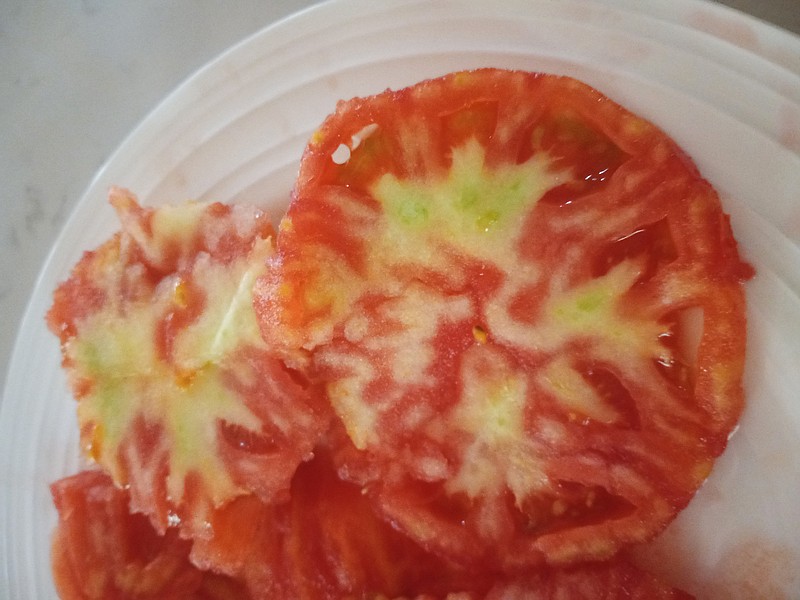Q: Why are tomatoes looking like the attached photo? They were like this last year.
A: Excessive heat, which we definitely had over the past weeks, can cause uneven ripening and tough, corky white interiors on tomatoes. The fact that you had it last year as well could indicate a virus. Take some samples to your local county extension office to send to the disease clinic.
■ ■ ■
Q: I recently sent you a photo of my arborvitae that was turning brown. I had no idea what was causing this problem, but now know that the devastation was caused by bagworms. I found tiny little worms emerging from the myriad of pods on the arborvitae and surrounding area. I had never even heard of bagworms until now, having learned about them the hard way. And that they love the arborvitae! My arborvitae is now 99% brown. If I replace this arborvitae with another arborvitae, how can I avoid a repeat of this attack by bagworms? Any suggestions that you might offer would be greatly appreciated.
A: Bagworms can devastate needle-type evergreens like arborvitae and junipers. Luckily for us, there is typically only one generation per year. Individual bagworms form small silk bags; the insects overwinter as eggs inside the female bag. There may be 300-1,000 eggs in a bag. The eggs begin hatching in mid- to late May, depending on the season. As they hatch, the small larvae crawl out the bottom of the bag and spin down on a strand of silk. These larvae on a string are often picked up by the wind and carried to nearby plants. When a suitable host plant is found, the young larva immediately begins to form a new bag. As the larva feeds and grows, it enlarges the bag and begins to incorporate bits and pieces of the plant material it is feeding on, giving it great camouflage. By mid-July to early August, the larvae are mature and they often move to a sturdy branch or other structure where they firmly attach to await next season. To prevent more trouble, remove the dying tree and get all bagworms out of your yard. Check neighboring plants as well. Hand-picking and destroying the bags can cut down on problems next year for neighboring or new trees. There are many insecticides to choose from, including bifenthrin (trade name Talstar). You can also use the organic Bacillus thuringiensis (BT, Dipel, Thuricide) or carbaryl (Sevin) or Orthene. The key is to apply insecticides according to label directions from mid- to late May through mid-June when the bagworms are in their juvenile stage and before the individual bag or sac is constructed, because that sac protects them from insecticides and predators. Once you see dried bags from late June on, the only control is hand-picking.
Q: Can you identify this plant for us? [The reader sent a photo.] We have not been able to find it online, probably because we do not know what category it is in.
A: The plant in question is commonly called dogfennel — Eupatorium capillifolium. It is a perennial weed. Some people like it for the feathery texture, but it grows quite tall and can spread by seeds. It is poisonous, so deer don't eat it.
■ ■ ■
Q: Can you tell me what plant the orange flower? [The reader sent a photo.] Is it related to red hot poker? It is in bed with mini euonymus and nandina.
A: The plant in question is Italian arum. Those are actually the berries that followed the white spathe-like bloom. Arums produce variegated foliage in the early spring. Then the plant produces a bloom similar to a peace lily houseplant. Once the seeds are set, the arum dies back until next year, leaving the naked seed stalk behind. The green seeds turn a bright orange or red when they are ripe.
■ ■ ■
Q: What is this tree? [The reader sent a photo.] Came across it in Hot Springs Village. Thanks for your help.
A: The tree in question is Paulownia tomentosa, commonly called Royal Paulownia or princess tree. Where you see the clusters of seed pods there were pretty clusters of purple flowers in the spring. While the tree is attractive in bloom, you can see how many seeds it produces. When the pods are mature, they will pop open and scatter seeds hither and yon. They freely germinate wherever they land — in flower beds, gutters and natural areas. When young, they grow extremely fast and the leaves are huge. As they mature, the leaves become a more normal size, but the tree is brittle and not long-lived.
Retired after 38 years with the University of Arkansas Cooperative Extension Service, Janet Carson ranks among Arkansas' best known horticulture experts. Her blog is at arkansasonline.com/planitjanet. Write to her at P.O. Box 2221, Little Rock, AR 72203 or email jcarson@arkansasonline.com
